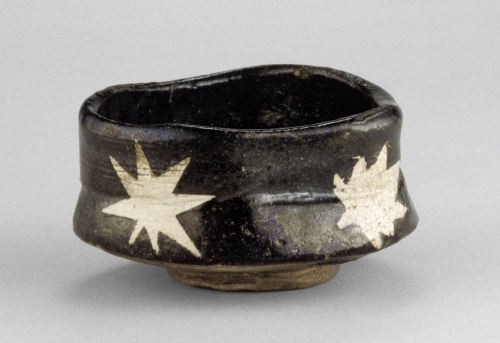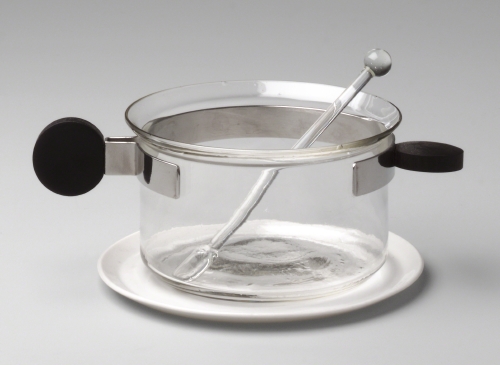National Hot Tea Month: Japanese Tea Bowls
I am sure most of you did not know that January is also National Hot Tea Month. Although the tea served in this bowl was most often cold by the time it was consumed, I feel that it is a beautiful tribute to the idea of TEA.
What works of art can you think of that conjure up steak, or Brussels sprouts, or quinoa (and don’t tell me about plastic bulls on steak restaurants)? Certain works of art are synonymous with certain foods/beverages. For example, many ancient Greek vase shapes were meant to store specific food items, e.g., the kantharos was a drinking vessel for wine. I’m sure in Western art you can imagine an art form when I mention “tea.”
 |
| Japan, Tea bowl, 1600s. Oribe (earthen) ware, height: 2 3/4" (7 cm). © Philadelphia Museum of Art. (PMA-2467) |
 |
| Joseph Albers (1888–1976, Germay/US); Bauhaus Metal Workshop (ca. 1919–1933, Dessau, Germany); Tea, Glass, Saucer, and Stirrer; 1925. Heat-resistant glass, porcelain, steel, and ebony; tea glass height: 2" (5 cm), diameter: 3 1/2" (9 cm). Museum of Modern Art, NY. © 2013 the Estate of Joseph Albers / Artists Rights Society, New York. (MOMA-D0060abars) |
The drinking of green tea has been known in China since the 300s CE. Tea planting began in Japan between 618 and 907 CE (Tang dynasty), the richest period of cultural exchanges between China and Japan. During the Nara period (710–794 CE), tea was consumed primarily by the wealthy and clergy as medicine. While tea drinking evolved from medicine to beverage in China during the Tang dynasty, it developed much later in Japan. Because tea was rare and valuable in Japan up until the 1200s, the Japanese formulated rules and formalities for its use, including the tea ceremony. Zen Buddhism was introduced into Japan around 1190 by a Japanese priest (Myoan Esai) who had studied in China. He is thought to have initiated the tea ceremony as a religious ritual. The strict rules of the tea ceremony are related to the Zen belief in paying attention to detail (in relation to being ready to receive enlightenment).
The tea bowl shape for the tea ceremony was quite different from those used for regular meals. Tea was ground into a powder before hot water was poured on it. It was then whisked in the cup with a bamboo whisk until froth appeared. By the end of the Muromachi period (1573), the tea ceremony had reached its peak of popularity with all classes in Japan. The typical space was small and sophisticated, devoid of decoration in order for concentration on the ceremony. Most often, one cup of tea was passed from one guest to another. There were even rules for the preferred type of tea bowl: typically simple in decoration with thick walls. The irregular rim speaks to the idea of spontaneity prevalent in Zen, in the sense that one never knows when enlightenment might come.
Studio activity: Create a personalized tea bowl. Using the pinch method, make a tea bowl that symbolizes personal values or likes. Take a ball of clay and press the thumb into the center. Keep turning the ball, pressing the clay from the bottom towards the top. Rotate the vessel with fingers on the outside and thumb on the inside to create the desired size bowl. Decorate either with applied clay designs or with slip painting.
Correlations to Davis programs: Exploration in Art Grade 3: 6.35; Exploration in Art Grade 6: 4.22; A Personal Journey: 3.4; A Global Pursuit: 7.5; Exploring Visual Design: 2, 6; The Visual Experience: 10.6, 13.5; Discovering Art History: 4.4


Comments